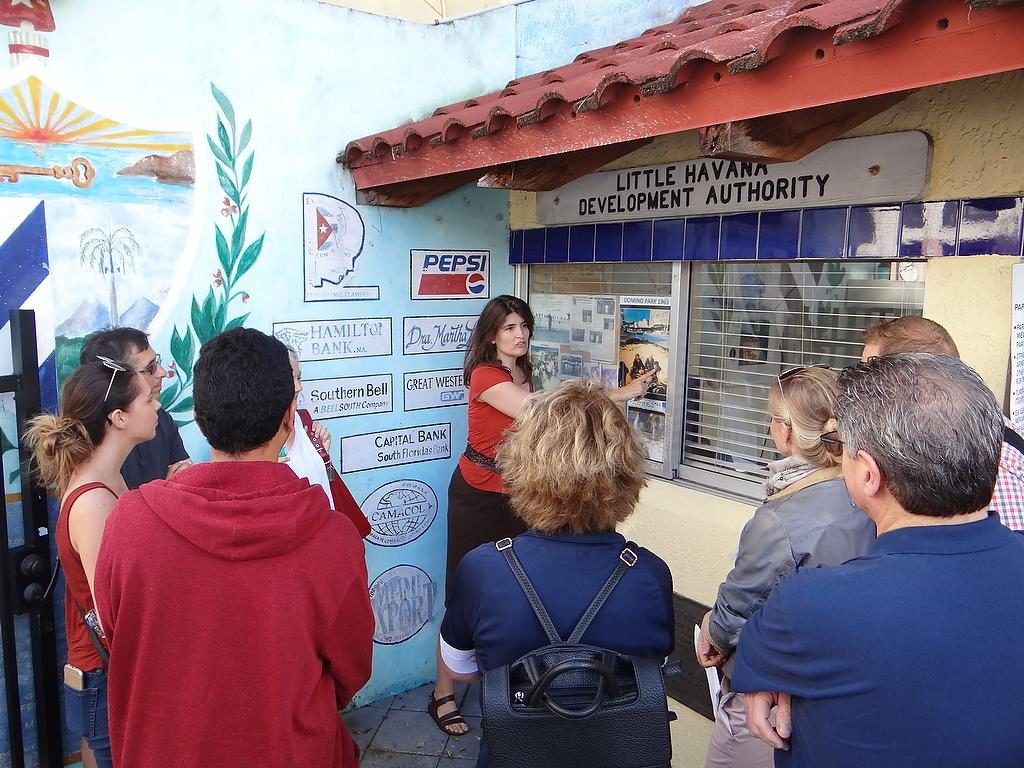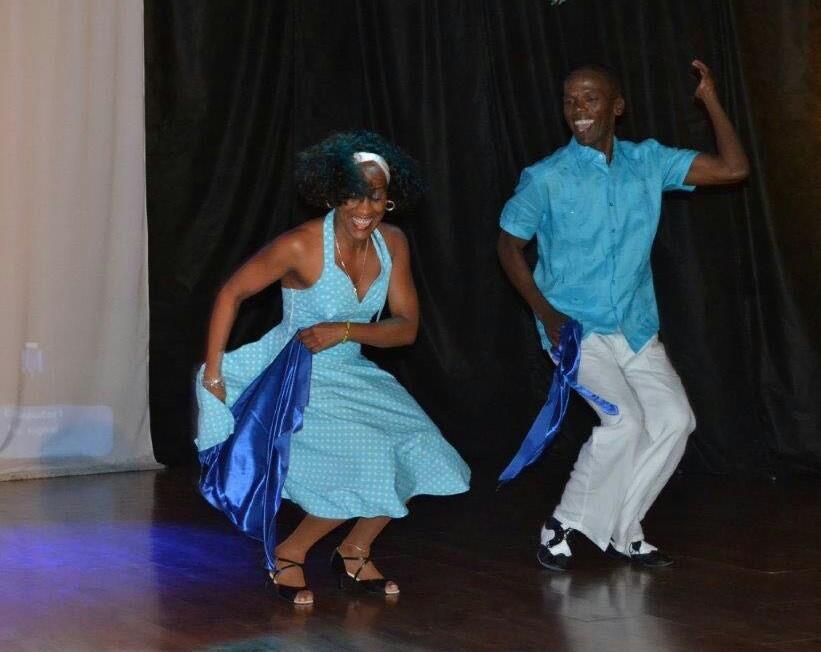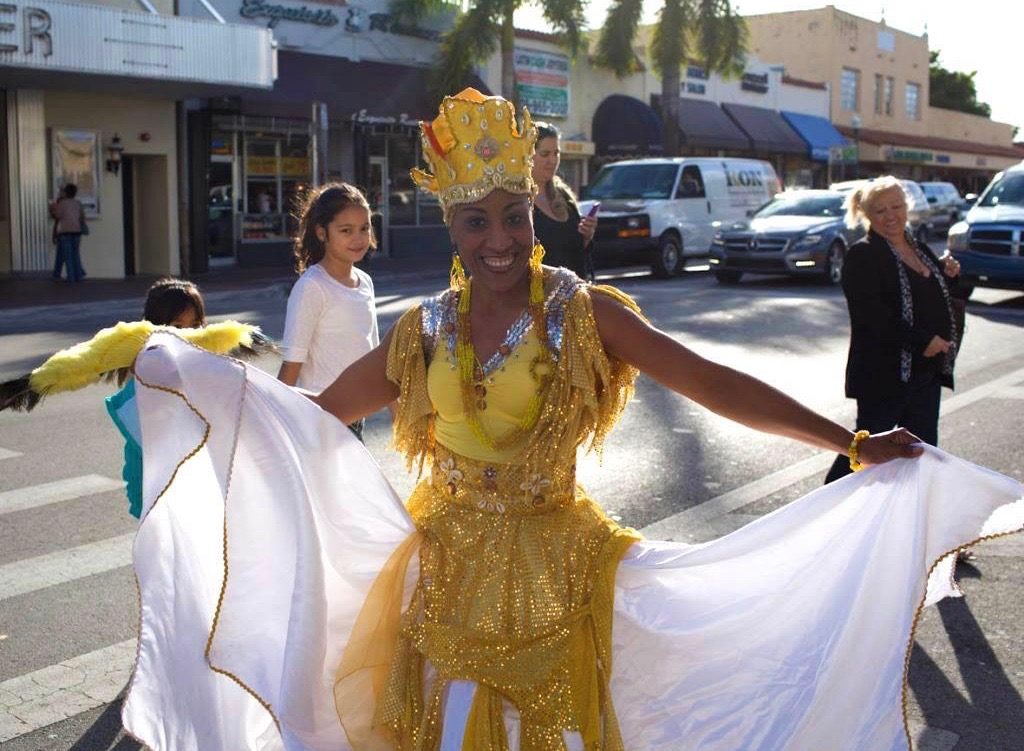A celebration of Afro-Cuban dance and culture in Little Havana
While Corinna Moebius isn’t a native of Miami, she is deeply rooted in Little Havana, her home of the last decade. She is the owner of Little Havana Tours, and was previously the Interim Executive Director of Viernes Culturales (Cultural Fridays) and Director of Imagine Miami (now Catalyst Miami), among other volunteer-based involvements in the Little Havana community.
Prior to moving to Miami, she had lived in Washington, D.C., where she was once the Chair of the Economic Diversification Committee for Adams Morgan Main Street and brought Afro-Cuban and West African dance to the dance plaza at the annual Adams Morgan Day Festival.
That was her gift to her neighborhood there, and now she would like to give a similar gift to her Little Havana neighborhood. She is a recipient of one of the 2017 Knight Arts Challenge grants in Miami for her #AfroOchoDance Festival, a forthcoming series of pop-up Afro-Cuban dance performances in the Calle Ocho Heritage District hosted in partnership with the Sikan Afro-Cuban Dance Project.

Moebius began giving walking tours of Little Havana the first year she arrived in Miami in 2006. She needed to learn the politics and dynamics of Miami and the Cuban community, and over the years dug deep into her own research on Little Havana and Calle Ocho, a historic arts district popular with tourists. She immersed herself in Little Havana, getting to know residents and business owners and familiarizing herself with local traditions, ultimately to battle stereotypes outsiders had developed about the neighborhood that was undermining it.
“I began developing my own narrative of the neighborhood; not just its history and cultural traditions but really promoting critical thinking about the ways people think about and imagine Little Havana and its history and its residents,” she says.
That included looking at who gets to tell the stories about Miami and about this neighborhood, and who gets excluded.
“Little Havana gets talked about as Miami’s Ellis Island. It’s not all Cuban – Cubans only make up about half the population here. There are also Central Americans, African Americans, and Mexicans. Little Havana is painted as this vibrant immigrant community but there is very little recognition of the racial dynamics of this neighborhood,” Moebius explains. “There is a desire among Afro-Cubans to also be acknowledged as part of the history of this neighborhood. Black Cubans and other people of African descent have made huge contributions to Little Havana and are also part of Cuban history, so for the festival we’re focusing on people of African descent.”

Moebius has long been involved in Afro-Cuban dance, having not only promoted it in D.C. but also studied in for many years under different instructors. For the #AfroOchoDance Festival she is partnered with the Sikan Afro-Cuban Dance Project led by Marisol Blanco, a renowned performer and teacher of Afro-Cuban dance and drumming who is also working to preserve and pass down Afro-Cuban cultural traditions.
Moebius specifically wants to use Afro-Cuban dance as a way to celebrate a people whose memories should not be erased from history: Afro-Cuban poets, leaders, artists, business owners, and military leaders who have made great contributions to the Cubanidad (“Cuban identity”) of Little Havana and Miami, and who continue to do so.
“Let’s use these dances to bring attention to these folks who deserve to be honored and remembered,” she says. “Let’s celebrate the richness of Afro-Cuban dance and music and let’s think about how we can use our public spaces for dance, and not just performances but social dance for the public.”
The #AfroOchoDance Festival will consist of eight different dance performances over eight days in eight different public spaces around the Calle Ocho district in Little Havana. The number eight is of particular significance: it is associated with Our Lady of Charity, the patron saint of Cuba; as well as Obatala, leader of the Orishas, which are spirits honored in the Afro-Caribbean religion Santería, developed when the African religion Yoruba was blended with colonial Catholicism as a result of the African slave trade. “Calle Ocho” also happens to mean “Eighth Street.”

Part one of the two-part festival will begin eight days before the last Friday of September, which is when the monthly arts festival Viernes Culturales will be held. Additionally, it will fall during Hispanic Heritage Month, acknowledging that Afro-Latinos also exist and tend to be ignored.
The second part will follow the same structure of eights, and will occur the following February, in 2019, during Black History Month. Moebius says holding the festival in two parts during these two distinct cultural heritage months is a further effort to make the festival as inclusive of different African diaspora identities as possible.
Each performance will represent a different form of folkloric Afro-Cuban dance beyond the rumba that people might be familiar with. The performances will be done in as “pop-ups,” so passers-by – including the millions of tourists who visit this area every year – will have no idea what they’re about to see. The goal is for people to simply encounter these performances, with no chairs and no formal division between the performers and the audience.
“Every performance is meant to open people’s eyes to what has been silenced and whose stories are not being told,” Moebius says. “With everything that has been going on around issues like Confederate monuments and Charlottesville, it’s all portrayed as white supremacists against African Americans, but we need to think more broadly. We don’t think about the more general silencing that takes place, even in spaces that we think of as having no racial tensions whatsoever. People think of Little Havana as an ethnic space and non-violent [since we don’t have these big battles over monuments or white supremacist rallies], but that becomes a way of hiding the fact that these racial tensions and silences pertaining to race continue to exist.”
“I find this whole idea of Little Havana as Ellis Island problematic because it portrays the neighborhood as this welcoming multicultural space for all residents, when in fact racialization and racism persists here, too,” she continues. “But a dance series can become an opening for learning, for sharing, for acknowledging the many histories and relations that ‘meet’ in Little Havana.”

The festival, she says, is as much about showcasing Afro-Cuban dance, culture, and legacy as it is about building bridges and to shine a light on the narrative exclusions that have taken place in order to think about “how can we move forward to build more inclusive representations and more inclusive public spaces.”
Moebius is currently working on a PhD in Cultural Anthropology from the Florida International University.The focus of her dissertation is on the racial politics of public memory and public space in Little Havana – a focus that, obviously, dovetails nicely with her work as a local tour guide and civically engaged Little Havana resident.
“Scholars don’t need to confine their research to academic circles,” she says. “If I’m doing this research why should I keep it locked away in a dissertation? Why not use what I’m learning from my fieldwork in a way that can benefit our cities, and give some food for thought to other people looking at creative memorialization and inclusion? And why not do it now? I don’t ever want to be someone just sitting in this ivory tower. I want to think of ways to engage students and others in important work that we can be applying in the here and now.”

(1) How do you like to collaborate?
I believe very strongly in collaboration: it’s an essential aspect of most of the projects I’ve been involved in, whether festivals or conferences or workshops. What can other individuals or institutions (e.g., nonprofits) bring to the table? A project collaborator can contribute ideas, special skills, resources, and so forth. How can we strengthen the value and impact of a project, build social capital (relationships), and re-affirm our respective individual or collective missions through our work together? In my case, I am collaborating with Marisol Blanco and her Sikan Afro-Cuban Dance Project, Brigid Baker and 6th Street Dance Studio, and Urban Impact Lab — and others TBD as well. Working together, we will all learn from each other, share with each other, and create something wonderful. And we’ll walk away having enhanced our knowledge, networks and access to resources, increasing the possibilities for future creative and important work. I’m always thinking of ways in which collaboration is mutually beneficial to all those involved. What helps with collaboration is clearly defining roles (who is doing what); maintaining communication; and clearly identifying what we hope to accomplish through our work together.
(2) How do you a start a project?
The project starts with an idea. I let it “percolate” by using mind mapping, making sketches, free writing. I “walk through” the idea for the project in my head. Then I start to bounce the idea off of people I would like to involve. What do they think? Do they like the idea? Is it possible? Do they want to be part of it? What are their ideas and suggestions? Who else could be involved? We brainstorm. We meet, and then we start to organize the project into something coherent, considering logistics, funding, marketing, collaborators, etc.
(3) How do you talk about your value?
I can talk about my value to anyone, because I know what my value is. I’m blessed that the mentors in my life, and my family, helped me recognize this value. For me, our “value” includes not only our gifts or talents, but also the ways in which we apply those gifts towards making this world a better place. I have a talent for inspiring, educating and connecting people (in a variety of ways), and I have strong leadership, communication and research skills. Great. But how do I use these gifts? I use them towards my personal mission: helping to build a more just, inclusive and sustainable world. I use my talents to build critical thinking skills—to get people get out of their mental boxes—and I’m particularly committed toward battling racial inequality, building equitable cities, and ensuring that public spaces are accessible, inclusive and welcoming to all. I can talk about my value; I prefer to demonstrate it through my actions.
(4) How do you define success?
I feel success when I realize that my work, or my actions, or my ideas, have contributed towards my mission. I feel success when I discover that individuals or groups I have brought together through events and projects are now collaborating with each other as a result, and are now impacting policy, programming, curriculum, etc. I feel success when realize people have arrived at “Aha!” moments based on my teaching, speaking or my writing, and are suddenly dismantling stereotypes and assumptions that had framed their world. I also feel success when I feel “flow.” It’s like the communion of rumba. You’ve got the underlying clave beat, but then everyone is contributing something: the congueros, the singers, the persons playing the palitos and the checkeré, the dancers. When it’s a successful rumba, it’s no longer about the individuals: we are in an act of collective CREATION, or FLOW. I want to help create the spaces where this can happen, whether in classrooms, on walking tours, or through events.
(5) How do you fund your work?
As someone who has been an entrepreneur for most of my career, I’m always thinking of “multiple streams of revenue.” When I worked at Catalyst Miami, I was successful at getting large grants. When I worked for Viernes Culturales, I created sponsorship packages and secured major corporate sponsors. I’ve organized and assisted with fundraisers. I’ve also worked on projects for which small businesses were sponsors. For this project, I will be using either GoFundMe or Indiegogo as my main tool for attracting contributions. One of the tips for attracting value, in my opinion, is considering what’s in it for the person or entity making the financial contribution. What is the value of your project? What will they get in return for helping to fund your project? Why should they trust YOU? I work very hard to deliver on what I promise to funders, sponsors and individual contributors alike. Trust is everything, and people remember your track record. When you demonstrate a strong track record, you increase your opportunity to fund future projects!
